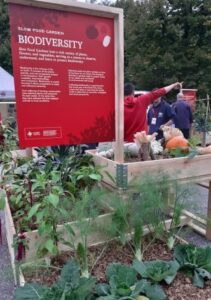
Biodiversity, Climate Action, Climate Change, Climate Change Justice, Conferences, COP29, Economy & Trade, Environment, Food and Agriculture, Food Security and Nutrition, Food Sustainability, Global, Green Economy, Headlines, Natural Resources, TerraViva United Nations

– Climate change has thrown our food systems into chaos. Extreme weather events and dramatic climate variations are hammering food production and supply chains across the world. As global leaders gear up for COP29, there’s plenty of buzz about climate action. But can we really expect these slow-moving, bureaucratic negotiations to deliver tangible and swift results to decarbonize and insulate our agri-food systems? Most likely not. But do not despair. While the COP29 talks unfold, crucial climate solutions for transforming food systems are already taking root on the ground.

Jesus Quintana
In the exhilarating, Oscar-winning movie “Everything Everywhere All at Once”, the leading characters are surrounded by overwhelming chaos and complexity. Yet, within this confusion, small actions, and the determination of people behind them, spark powerful change. In stunning similarity, the climate crisis —particularly in food systems— feels like an insurmountable challenge with everything, droughts, floods, storms, hunger and other interlocked crises, striking everywhere, and all at once.
Urgent action is needed. Where do we turn? COP 29 will likely be stuck in slow-paced discussions. Meanwhile, transformative solutions are taking shape on the ground. Across the globe, communities, farmers, sponsors and innovators are quietly building resilience in their food systems, demonstrating that true progress often emerges from the margins, not the center of chaos. Just like in the metaphoric film, finding purpose and action amid disorder is where meaningful change begins.
Grassroots solutions for climate-resilient food systems
While world leaders talk and officials try to turn decisions into workable policies, local communities are already acting. Across the Global South, where the effects of climate change are being felt most acutely, smallholder farmers and grassroots organizations are implementing innovative practices that build resilience to climate shocks.
In regions like Sub-Saharan Africa and parts of Latin America, agroecology is gaining traction as a powerful tool for both mitigating and adapting to climate change. This farming approach, which draws on traditional knowledge and emphasizes sustainable, low-emission methods, is helping communities adapt to changing weather patterns while improving food security. Agroecology promotes biodiversity, improves soil health, and reduces dependency on chemical inputs, all of which enhance the resilience of agricultural systems to climate impacts and helps decarbonize them.
The private sector’s role in transforming food systems
Community movements and local governments are playing a vital role, but the private sector is also increasingly driving climate solutions in food systems. Market forces are pushing companies to innovate in ways that reduce agriculture’s climate footprint. The plant-based food revolution is an example of how the private sector is responding to the need for more sustainable diets that lower greenhouse gas emissions. Similarly, alternative protein food-tech startups are leading the way towards a sustainable and tasty food future. These unconventional substitutes for traditional livestock farming offer a glimpse of how innovation can drive systemic changes in food production.
In addition to product innovation, there is growing corporate investment in regenerative agriculture—a practice that rebuilds soil health, captures carbon, and improves biodiversity. Large food companies, driven by consumer demand for sustainable products, are making commitments to source ingredients from regenerative farms, contributing to both climate mitigation and long-term food security.
Climate finance outside the COP processes
One of the most significant barriers to transforming food systems in the face of climate change is the lack of adequate financing. While COPs have made important commitments, such as the creation of the Green Climate Fund, the flow of funds has been slow and insufficient to meet the needs of vulnerable communities. In response, philanthropy and private finance are stepping in.
Some patrons and foundations are funding initiatives that help smallholder farmers adapt to climate change, while impact investors are supporting agri-tech innovations that boost productivity in a sustainable way. These efforts, although outside the COP framework, are critical in scaling climate-resilient food systems and achieving global net-zero targets.
Real solutions are happening now
While COP29 will no doubt produce important global agreements, the truth is that many of the solutions to the climate crisis—especially when it comes to food—are already in motion. Farmers, local communities, philanthropies and private companies are building a food system that is more resilient, sustainable, and low-carbon.
Global leaders must take notice. Yes, we need ambitious targets and international commitments. But we also need to support and scale the grassroots movements and private-sector innovations that are already leading the way. Real food security in a climate-challenged world will not be achieved through top-down solutions alone—it will come from empowering those on the frontlines.
As COP29 approaches, let’s not lose sight of what is happening beyond the negotiation tables. The future of food security depends on action today, led by those who can’t afford to wait.
Jesus Quintana is Senior Advisor on Sustainable Food Systems and former Director General, CIAT
IPS UN Bureau












